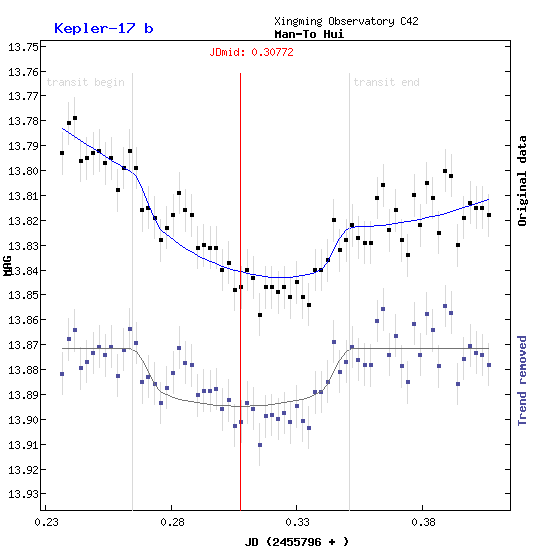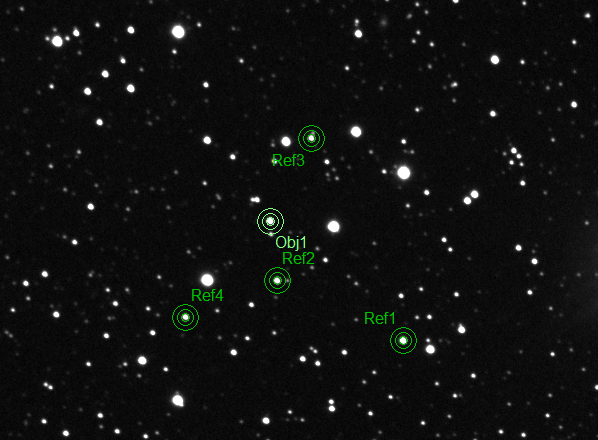
Introduction
Kepler-17 b is positioned at (J2000) R.A. = 19h53m34s.86, De. = + 47°48'54".0, in Cygnus, the host of which has 14.141 Vmag. According to the Exoplanet Transit Database (ETD), the transit leads to a decrease in brightness of its star seen from the earth is 0.0213 mag, and the duration is about 136.6-min.
The equipment used for the monitor was 14" SCT f/6.9 + QHY9 CCD.
Overall 280 images with individual exposure 43s were remotely taken by Xing Gao, from Urumqi, China at predawn on Aug 23 local time, which were later callibrated with bias, dark, and flat frames in MaxIm DL. Subsequently I sort these individual images into quadruplets, which were stacked in Astrometrica by means of median. As MPO Canopus refused to measure some of the series, I had to use MaxIm DL to measure the lightcurve.
Here comes the data:
J. D. HEL. KEPLER-17B +/- ------------- ---------- ------- 2455796.23687 13.793 0.002 2455796.23932 13.781 0.002 2455796.24174 13.779 0.002 2455796.24417 13.796 0.002 2455796.24661 13.795 0.002 2455796.24905 13.793 0.002 2455796.25148 13.792 0.002 2455796.25391 13.797 0.002 2455796.25635 13.795 0.002 2455796.25878 13.808 0.002 2455796.26123 13.799 0.002 2455796.26367 13.792 0.002 2455796.26612 13.799 0.002 2455796.26856 13.816 0.002 2455796.27101 13.815 0.002 2455796.27347 13.819 0.002 2455796.27591 13.828 0.002 2455796.27835 13.823 0.002 2455796.28080 13.818 0.002 2455796.28325 13.809 0.002 2455796.28569 13.816 0.002 2455796.28814 13.818 0.002 2455796.29058 13.831 0.002 2455796.29307 13.830 0.002 2455796.29552 13.831 0.002 2455796.29797 13.831 0.002 2455796.30042 13.840 0.002 2455796.30289 13.837 0.002 2455796.30533 13.848 0.002 2455796.30778 13.847 0.002 2455796.31024 13.840 0.002 2455796.31269 13.843 0.002 2455796.31514 13.858 0.002 2455796.31760 13.847 0.002 2455796.32004 13.847 0.002 2455796.32250 13.849 0.002 2455796.32496 13.847 0.002 2455796.32741 13.851 0.002 2455796.32987 13.845 0.002 2455796.33231 13.851 0.002 2455796.33476 13.854 0.002 2455796.33722 13.840 0.002 2455796.33968 13.840 0.002 2455796.34213 13.836 0.002 2455796.34459 13.820 0.002 2455796.34704 13.832 0.002 2455796.34950 13.828 0.002 2455796.35195 13.822 0.002 2455796.35441 13.827 0.002 2455796.35687 13.829 0.002 2455796.35932 13.829 0.002 2455796.36177 13.811 0.002 2455796.36423 13.806 0.002 2455796.36669 13.824 0.002 2455796.36914 13.816 0.002 2455796.37160 13.828 0.007 2455796.37406 13.834 0.002 2455796.37652 13.810 0.002 2455796.37898 13.822 0.002 2455796.38144 13.805 0.002 2455796.38391 13.811 0.002 2455796.38636 13.825 0.002 2455796.38883 13.800 0.002 2455796.39129 13.802 0.002 2455796.39377 13.830 0.002 2455796.39623 13.819 0.002 2455796.39871 13.813 0.002 2455796.40118 13.815 0.002 2455796.40364 13.815 0.002 2455796.40610 13.818 0.002
The following plots were generated in the course of ETD. The upper one plots raw data, whereas the lower one plots data with correction to systematic errors by means of both linear power and parabolic fit.

The following figure plots the residuals after the fit correction.

The plots shows the airmass versus time. As seen from the graph, the altitude of the target was setting lower during the observation in that the airmass kept in a tendency of incline.

Overall 4 reference stars were taken adjacent to the target, as shown in the following image. Magnitude sources were taken from USNO-A 2.0 star catalog in R band, rendered in Canopus.

The lightcurve looks gruesome. Initially I thought it was due to interference from clouds. However, when tracing back within the individual images one by one, I found nothing whatsoever. I also redid the measurement with non-stacked post-callibration images and stacked-in-quintuplet images in another sofware FotoDif, yet the tendency of the lightcurve showed little change. Later I thought up of the most serious condition when the monitor was on -- moonlight. I suspect whether there were some clouds passing through the moon resulting in brightness variation in the sky background. Thus far it is the most plausible explanation.
ETD measures the mid-transit time, duration and depth for me, respectively JD 2455796.30538 ± 0.0018, 124.0 ± 6.5 min, 0.0231 ± 0.0039 mag. The radius of the exoplanet is also estimated: Rp = 1.443 -0.126+0.116 RJup, where RJup denotes the radius of Jupiter, whereas the currently acknowledged value is Rp = 1.312 ± 0.018 RJup.
More observations are needed to remove occasional errors before the calculation in good accuracy.
Copyright © Man-To Hui 2011/09/09
Feel free to e-mail me with any doubts or questions.